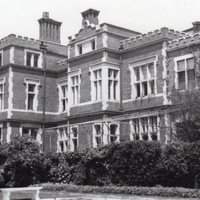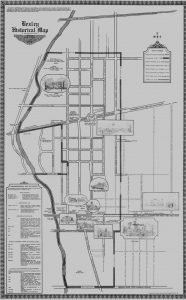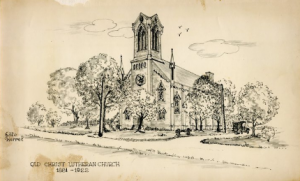
Did you know that Bexley was founded at a meeting at the Jeffrey Mansion on the northwest corner of North Parkview and Clifton Avenue August, 1908? The meeting was organized by representatives of two residential neighborhoods that began to form in the farmland east of Alum Creek at the turn of the 20th Century.
Daniel Boorstin describes the American movement to the suburbs in the early decades of the 20th Century as “an internal migration which, for speed, was without precedent in American life.”1
- A 1908 map of Bexley shows the lots that had been laid out near its western edge by John Bullitt of Philadelphia, PA – called the Bullitt Park Division – extending north and south of Broad Street with Cassady Avenue as it’s eastern boundary.
- King Thompson and Charles F. Johnson were partners in the real estate development firm called the Dominion Land Co. that laid out a plat of lots by 1908 called the Ardmore Addition just east of Cassady.2

One neighborhood group had just incorporated the previous year as the Pleasant Ridge Association (PRA). The boundary from the more financially endowed group to the north was East Town (now Bryden Road). The community originated in large part from the founding of Capital University in 1876. They wanted to form a village outside Columbus, but were short on the know-how and the contacts needed to petition Marion County and to free themselves from Columbus’ claims to the area. This group, by the 1910 United States Census, included approximately:
- 19 households on Main Street
- 14 on Pleasant Ridge (Vine until 1908)
- 37 on College Avenue
- 16 on South Parkview (some near Main Street)
- 2 on Drexel near Main
Other real estate divisions also were in the making at this time. Check the abstract belonging to your home giving its history at least up to the nineteen fifties or sixties – if you are so fortunate to have one.
Though these households are too many to list here individually, a few men are discussed, since they took part in early village government, or were prominent citizens of the community – in order to provide a socioeconomic flavor of what was to become the City of Bexley.
Housing was being extended out to the 2100 and 2200 blocks of Main Street, east of Alum Creek. Along with the family members and their ages, the 1910 census provides us with the occupations and country of birth of each person.3 Here we locate a number of professors at Capital University, such as Carl R. Ackermann, Frederick W. Stellhorn, George K. Leonard and Simon A. Singer. Lewis H. Schuh was listed as president.
Those individuals in retail sales included Frederick J. Genger, meat cutter; William Seidensticker, dry goods; and Elias E. Bock, grocer. Charles Wells was listed as physician and Rollin B. Cochrone as dentist.
On Pleasant Ridge, among others listed, are John H. Williams, a household including a greenhouse, listed as florist; George W. Kneeland, carpenter-builder; and Frank C. McVay, confectionery owner.
Those on College Avenue included Everett D. Barnett, barber; George Petzinger, carpenter-contractor; Grant J. Herr, butcher; Charles Petzinger, carpenter-builder; William D. Petty, dairyman; George E. Fry(e), lumberyard foreman; and George A. Wannemacher, farmer/rancher.
On South Parkview, near Main, Frank G. Holtzman is listed as President, H. Holtzman & Sons, manufacturer, piano stools.
The second cluster of properties evolved around the mansion built in 1905 by Robert H. Jeffrey, Vice President of the Jeffrey Manufacturing Co. and son of Joseph A. Jeffrey, president and founder of the coal mining machinery company located in Columbus. His 34-acre estate led the way for others listed in the 1910-11 Polk’s Columbus City Directory to be built on North Parkview, such as Lincoln Kilbourne, purchasing agent, the Kilbourne & Jacobs Mfg. Co.; and Edward H. Huggins, Attorney-at-Law.
Max Morehouse, president and treasurer, Morehouse-Martin’s Department Store (downtown) and Frank D. Chamberlain, president, Peoples Credit Clothing Co. (downtown)4, resided on South Columbia and Bullitt Park, respectively, just off Broad Street. They also challenged the claim that Columbus had annexed the area.
The 1910 United States Census lists approximately five residents on East Broad Street, four on North Parkview, and five on South Columbia.
Obviously, their shortcoming was that there were too few residents to form a village. Robert Jeffrey had just recently finished his term, beginning at the age of twenty-nine, as mayor of Columbus, and was a natural to lead the fight for separate status, as a village, that was finally won a few years later – before the Ohio Supreme Court.

Other than McVay’s Confectionery, opened in 1908, located just outside Bexley on the southwest side of Alum Creek on Main Street, retail stores only began to be listed in Polk’s Directory by 1913. Everett Barnett’s barbershop became famous because it was the location of the village government telephone. Stukey’s Drug Store occupied the west half of what is now Graeters – and Klingbeil Grocers occupied the east half. These stores were clustered around Main and Drexel with the old Christ Lutheran Church, opened in 1880, on the northwest corner.
A few quotes from summaries, edited by members of the Bexley Historical Society, from early village council meetings provide some interesting insights on who participated in village government, and on what civic tasks needed to be accomplished. “The first meeting was held August 10, 1908 with Mayor Holtzman assisted by councilmen Huggins, Brook, Goble, Leonard, village clerk George Frye, and treasurer Lewis H. Schuh. Then at the 17th of August, 1908 meeting, Councilmen Petzinger and Kilbourne appear in the minutes. The first ordinance passed by the Council was to prohibit stock from running at large, prohibit disorderly conduct, set a fine for intoxication and for discharging firearms.5 In 1909, the first real estate tax of five mills was passed. By 1912 new faces on the village council included Mayor Frank D. Chamberlain, Kneeland, Wannamacher, and Conners.
Here is a glimpse of the beginnings of Bexley. Future articles in our newsletter will hopefully answer some of your questions on Bexley’s evolution. Our biographical files, available for perusal, cover some of the families mentioned above. The historical society, in conjunction with the Bexley Public Library, is developing an online resource of the addresses and houses of many of the early residents in Bexley. We appreciate receiving copies of any early pictures, genealogies, or writing related to the Bexley community or its family life.
Adapted from article By Edward L. Hamblin
Bexley Historical Society President, 1997-2002
Originally published in Historical Herald, July 2004
If you have information to add to this topic, please let us know.
All comments are reviewed before posting.
1 Boorstin, Daniel J., THE AMERICANS-THE DEMOCRATIC EXPERIENCE, Random House: NY, 1974, P. 287
2 Telephone interview, April 28, 2004, with Mary Jane Bolon, granddaughter of Charles F. Johnson.
3 POLK’S COLUMBUS CITY DIRECTORY, 1910-11, Ackermann, p.83; Stellborn, p.1096; Leonard, p.698; Singer, p.1058; Schuh, p.1018; Genger, p.457; Seidensticker, p.1030; Bock, p.168; Wells, p.1200; Cockrone, p.265; Williams, p.1226; Kneeland, p.660; McKay, p.759; Barnett, p.126; G. Petzinger, p.905; Herr, p.546; C Petzinger, p.905; Petty, p.905; Fry(e), p.442; Wannemacher, p.1183; Holtzman, p.568.
4 POLK’S COLUMBUS CITY DIRECTORY, 1910-11, R Jeffrey, p.606; Kilbourne, p.648; Huggins, p.548; Morehouse, p.824; Chamberlain, p.245.
5 Summary Notes Early Council Meeting, unpublished at Bexley Historical Society
